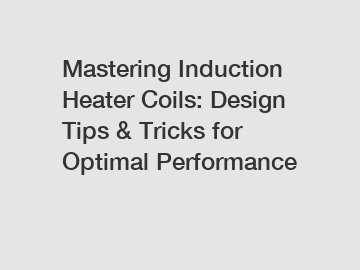Mastering Induction Heater Coils: Design Tips & Tricks for Optimal Performance
Mastering Induction Heater Coils: Design Tips & Tricks for Optimal Performance.
Induction heating is a remarkable technology that has revolutionized various industries, from manufacturing and automotive to healthcare and cooking. At the heart of this innovation lies the induction heater coil, a crucial component responsible for generating the necessary electromagnetic fields for heating applications. To truly harness the power of induction heating, it is essential to master the design and optimization of induction heater coils. In this blog, we will delve into the intricate details of coil design, providing you with valuable tips and tricks to achieve optimal performance.
Understanding the Basics:

Before diving into the intricacies of induction heater coil design, let's start by unraveling the basic principles behind this technology. Induction heating relies on electromagnetic induction, which is the process of generating heat within a conductive material by subjecting it to a rapidly changing magnetic field. The heater coil acts as the primary source of this magnetic field, and the material to be heated, placed within the coil's vicinity, acts as a secondary conductor.
Designing for Efficiency:
Efficiency is of utmost importance when it comes to induction heating, as it directly affects productivity and cost-effectiveness. To maximize efficiency, several factors need to be taken into consideration during the design process. One key aspect is the selection of the appropriate coil geometry, such as the number of turns and their spacing. This choice significantly impacts the distribution and intensity of the magnetic field, thus affecting heating performance.
Additionally, considering the material of the coil is crucial. Copper is commonly used due to its excellent electrical conductivity and resistance to high temperatures. However, aluminum can be a viable alternative for low-frequency applications. By carefully selecting the coil material, one can minimize resistive losses and ensure efficient energy transfer.
Optimizing Coil Inductance:
The inductance of an induction heater coil plays a vital role in achieving optimal performance. Higher inductance values facilitate the generation of stronger magnetic fields, thus increasing heating capabilities. To maximize inductance, one can experiment with various coil geometries, such as using a helical winding pattern. Additionally, introducing ferrite or powdered iron cores within the coil can enhance inductance through magnetic flux concentration.
Balancing Resistive and Eddy Current Losses:
Resistive and eddy current losses are common hurdles in induction heating systems. Resistive losses occur due to the coil's electrical resistance, leading to the generation of unwanted heat within the coil itself. To minimize these losses, it is essential to utilize materials with low resistivity, such as copper or silver-plated copper.
On the other hand, eddy currents are induced within the material being heated, leading to energy dissipation and reduced efficiency. Employing laminated or ferritic cores within the coil can help to suppress eddy currents, as these materials impede the flow of magnetic fields perpendicular to their surfaces.
Cooling Techniques:
Induction heating generates significant amounts of heat, necessitating effective cooling mechanisms to prevent coil overheating and subsequent performance degradation. Employing cooling channels or fins within the coil design can improve heat dissipation. Additionally, using liquid cooling systems, such as water or oil, can efficiently regulate temperature during prolonged heating applications.
Considerations for Frequency and Power:
The operating frequency and power level greatly influence the design and performance of induction heater coils. Higher frequencies generally enable faster heating rates but may require smaller coil sizes. Conversely, lower frequencies allow for deeper penetration but can result in larger coil dimensions. It is crucial to strike a balance between these parameters to meet the specific requirements of your application.
Conclusion:
Mastering the design of induction heater coils is a complex task that requires careful consideration of several factors. By optimizing the coil geometry, selecting suitable materials, balancing resistive and eddy current losses, implementing effective cooling techniques, and considering the frequency and power requirements, one can achieve optimal performance in induction heating applications. Keep experimenting, refining, and exploring new possibilities in coil design to harness the full potential of this remarkable technology.
Are you interested in learning more about induction billet heating, induction bend pipe, induction brazing machine manufacturers? Contact us today to secure an expert consultation!

Comments